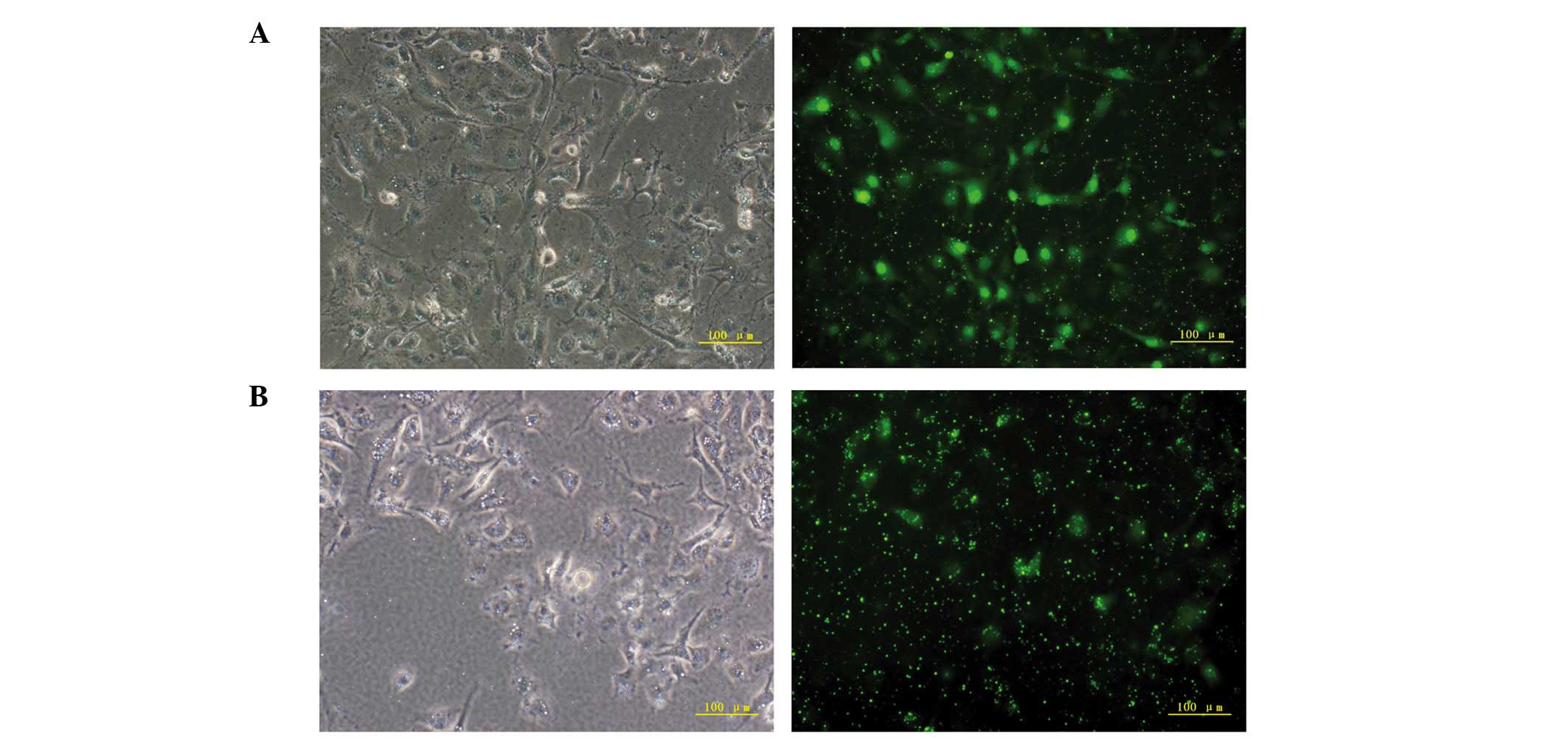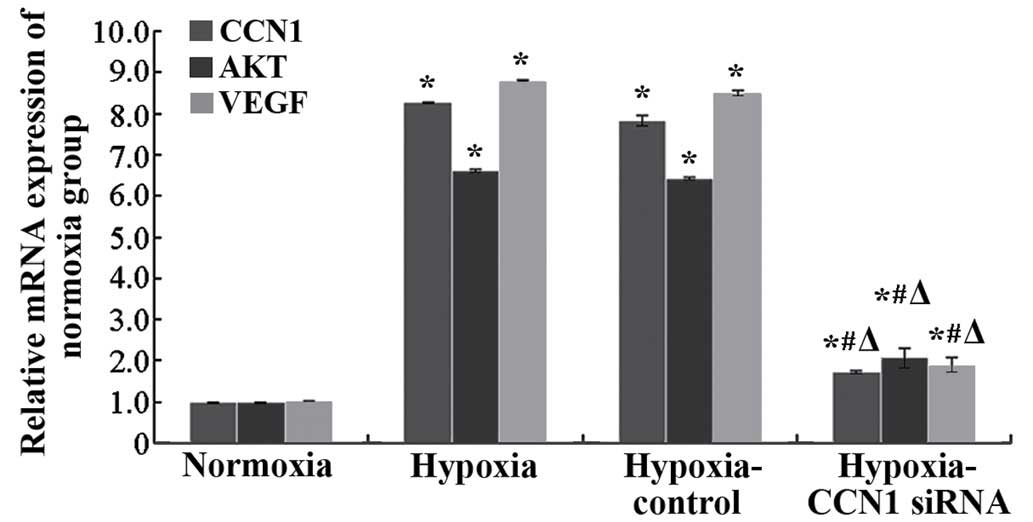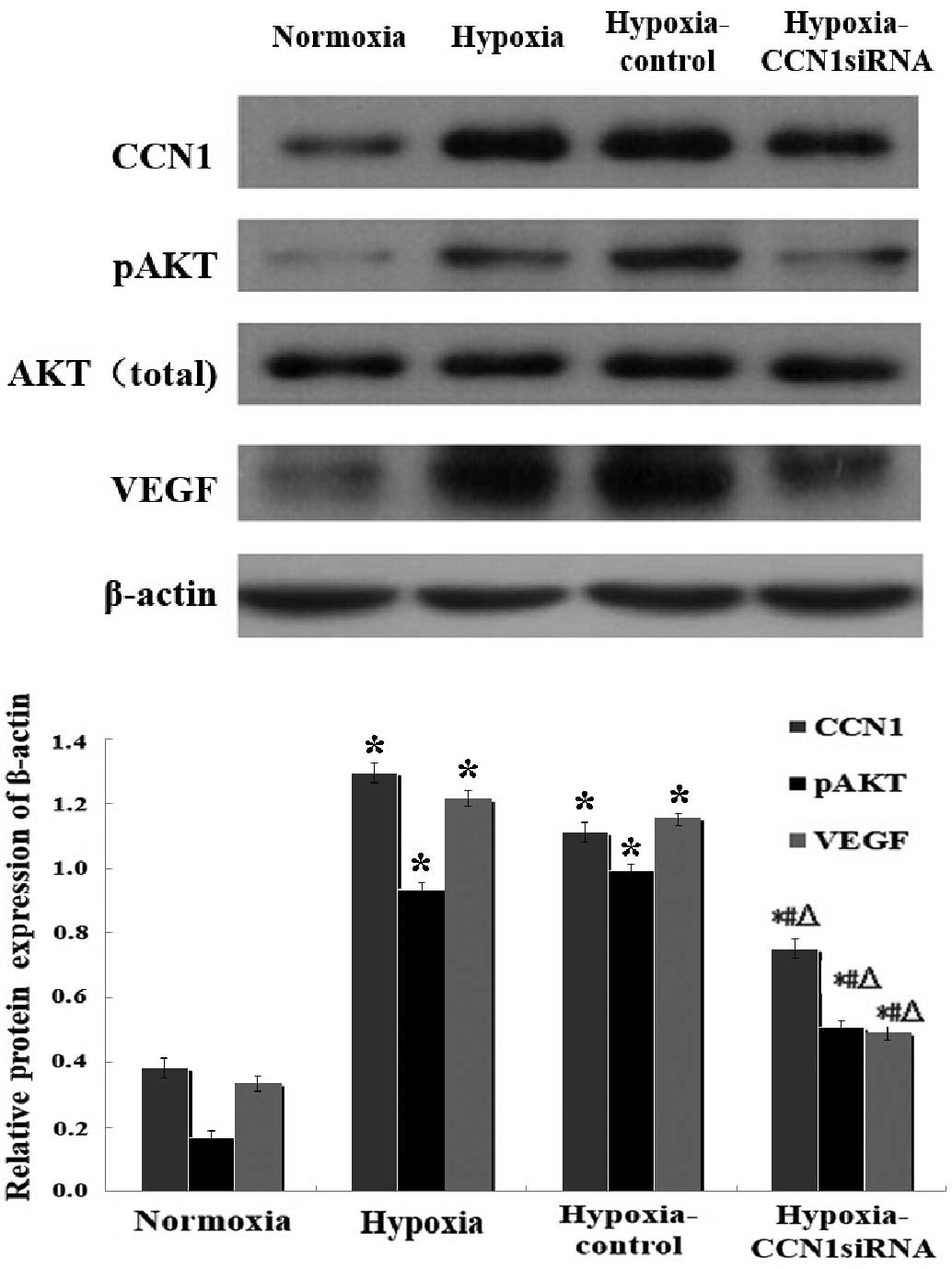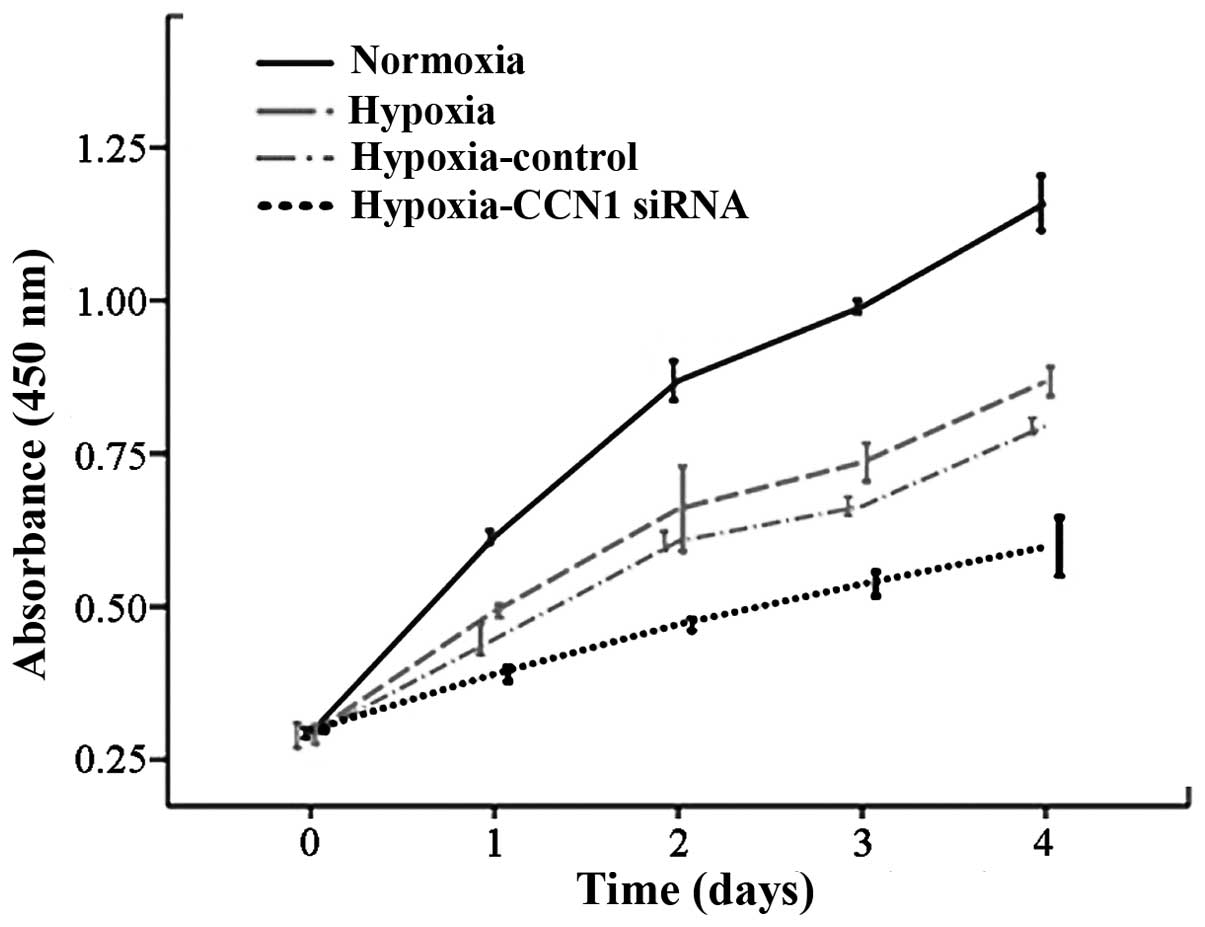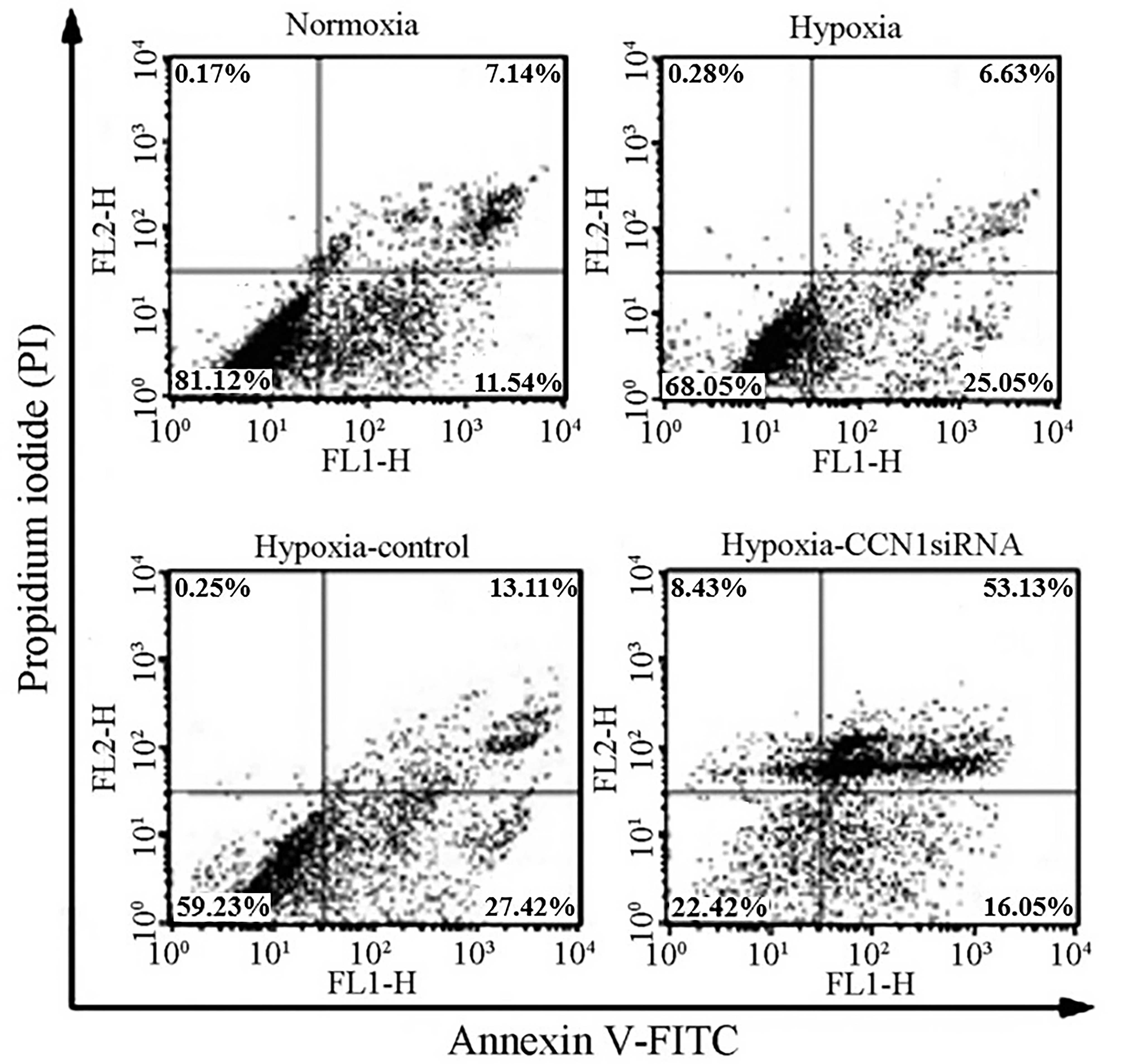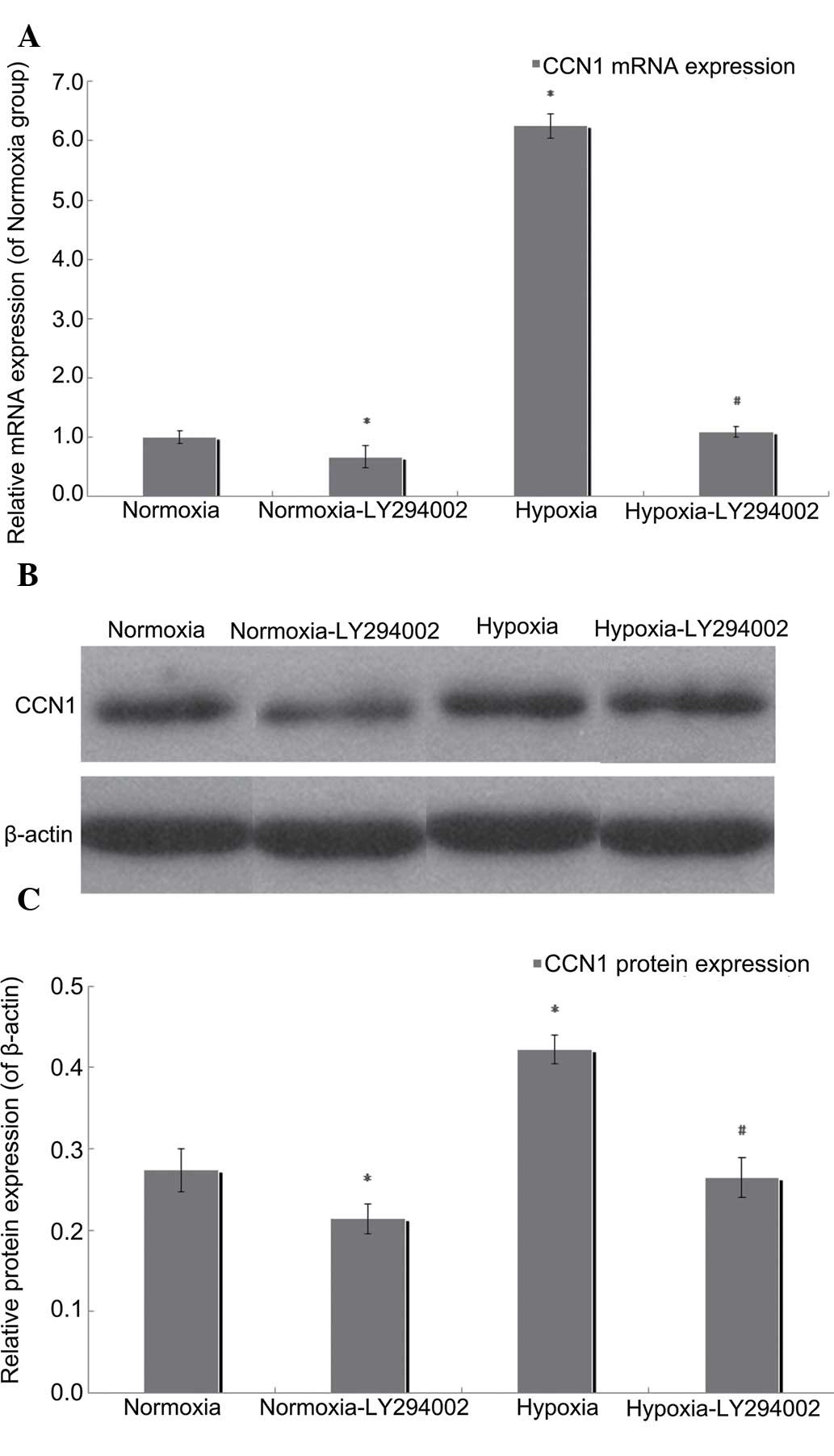Cysteine‑rich 61 RNA interference inhibits pathological angiogenesis via the phosphatidylinositol 3‑kinase/Akt‑vascular endothelial growth factor signaling pathway in endothelial cells
- Authors:
- Published online on: September 26, 2016 https://doi.org/10.3892/mmr.2016.5772
- Pages: 4321-4327
Abstract
Introduction
Hypoxia is a common pathophysiological phenomenon, which has a profound impact on endothelial cell (EC) properties in numerous pathological angiogenic diseases, including retinopathy of prematurity, proliferative diabetic retinopathy, retinal vein occlusion and age-related macular degeneration (1,2). These diseases are a major cause of blindness worldwide, however, there remains a lack of effective medical treatment options. Therefore, understanding the association between hypoxia and pathological angiogenesis may be important in characterizing the mechanisms of disease and assist in the development of novel treatment strategies.
Cysteine-rich 61 (CCN1), the first cloned member of the CCN family, mediates cell adhesion, stimulates chemotaxis, augments growth factor-induced DNA synthesis, fosters cell survival and enhances angiogenesis (3–5). Previous studies have demonstrated that hypoxic conditions are able to induce the expression of CCN1 in several types of cell (6–11). The phosphatidylinositol 3-kinase (PI3K)/Akt pathway is involved in multiple cellular processes, including cell survival and differentiation, and it has been demonstrated to be important in angiogenesis (12). Previous studies have demonstrated that CCN1 induces monocyte chemotactic protein 1 through the activation of PI3K/Akt and nuclear factor-κB signaling in chorioretinal vascular ECs (13). Additionally, a previous study indicated that CCN1 can enhance the expression of vascular endothelial growth factor (VEGF) and promote tumor neovascularization via the PI3K/Akt signaling pathway (14).
However, the specific mechanisms, which are involved in CCN1-mediated pathological angiogenesis in ECs remain to be fully elucidated. The present study hypothesized that the CCN1/PI3K/AKT/VEGF signaling pathway may be associated with pathological angiogenesis and comprise possible molecular therapeutic targets. In order to confirm this hypothesis, the present study investigated the effect of reducing the expression of CCN1 in hypoxic ECs, and analyzed the molecular mechanisms involved in pathological angiogenesis.
Materials and methods
Cell culture
HUVECs were purchased from Cell Systems Corporation (Kirkland, WA, USA) and were cultured in Dulbecco's modified Eagle's medium (GE Healthcare Life Sciences, Chalfont, UK) with 10% fetal bovine serum (Thermo Fisher Scientific, Inc., Waltham, MA, USA) at 37°C in a humidified atmosphere containing 95% air and 5% CO2, with subconfluent monolayers passaged 3–10 times prior to treatment.
Hypoxic treatment
Hypoxic exposure was performed using a tightly sealed molecular incubator chamber (Billups-Rothenberg, Inc., Del Mar, CA, USA), which was tightly sealed and flushed with a gas mixture containing 1% O2, 94% N2 and 5% CO2, as previously described (15,16), with the cell culture dishes containing 1×105 cells/well placed in the chamber and incubated at 37°C for 24 h.
The HUVECs were divided into four groups: A normoxia group; a hypoxia group; a hypoxia-control group, which was transiently transfected with scramble small interfering (si)RNA; and a hypoxia-CCN1 siRNA group, which was transiently transfected with CCN1 siRNA. The HUVECs were transiently transfected with plasmids (500 ng/µl) using Lipofectamine® 2000 (Invitrogen; Thermo Fisher Scientific, Inc.) for 48 h.
PI3K/Akt inhibition
The PI3K/Akt inhibitor, LY294002, was used in the present study to determine the effect of inhibiting the PI3K/Akt pathway on the normoxic and hypoxic HUVECs. The cells were cultured under normoxic or hypoxic conditions in six-well plates at a density of 1×105 cells/well as described above, in the presence of LY294002 (Sigma-Aldrich, St. Louis, MO, USA). The solution comprised 40 µmol/l dissolved in dimethyl sulfoxide (DMSO), with a final concentration of DMSO in the cell culture of 0.1%. The cells were pretreated with LY294002 for 30 min prior to being placed in the incubator for hypoxic exposure. The mRNA and protein expression levels of CCN1 were then analyzed using RT-qPCR and western blotting, respectively, following 24 h normoxia or hypoxia.
Gene knockdown by siRNA
Four pairs of CCN1 siRNA sequences were designed and synthesized (Shanghai GenePharma Co., Ltd., Shanghai, China), with one pair selected based on stability and effectiveness. The sequences were as follows: CCN1 (Cyr61-homo-553) forward, 5′-GGGAAAGUUUCCAGCCCAACUTT-3′ and reverse, 5′-AGUUGGGCUGGAAACUUUCCCTT-3′; CCN1 (Cyr61-homo-789) forward, 5′-GAGGUGGAGUUGACGAGAAACTT-3′ and reverse, 5′-GUUUCUCGUCAACUCCACCUCTT-3′; CCN1 (Cyr61-homo-1072) forward, 5′-GCAAGAAAUGCAGCAAGACCATT-3′ and reverse, 5′-UGGUCUUGCUGCAUUUCUUGCTT-3′; CCN1 (Cyr61-homo-1268) forward, 5′-GAUGAUCCAGUCCUGCAAAUGTT-3′ and reverse, 5′-CAUUUGCAGGACUGGAUCAUCTT-3′. In addition, a non-silencing siRNA sequence was selected for use as a negative control (forward 5′-UUCUCCGAACGUGUCACGUTT-3′ and 5′-ACGUGACACGUUCGGAGAATT-3′ reverse). The siRNAs were cloned using a pGPU6/green fluorescent protein (GFP)/Neomycin resistance screening marker (Neo) siRNA Expression Vector kit (cat. no. E-07/F-07; Shanghai GenePharma Co., Ltd.), according to the manufacturer's protocol, generating the pGPU6/GFP/Neo-CNN1 siRNA and the pGPU6/GFP/Neo-scramble siRNA plasmids, which contained Bbs1 and BamH1 restriction sites. The cells were transfected, according to the manufacturer's protocol, with the mRNA and protein levels assessed 48 h following transfection. siRNA was successfully transfected into HUVECs in six-well culture plates, with each well containing 240 pmol fluorescent labelled siRNA and 8 µl Lipofectamine® 2000 for 6 h. Transfection efficiency was determined using fluorescence microscopy (FV1000; Olympus Corp., Tokyo, Japan).
Cell proliferation assay
A Cell Counting Kit-8 (CCK8) assay (Beyotime Institute of Biotechnology, Jiangsu, China) was used to measure cell proliferation, according to the manufacturer's protocol. Briefly, HUVECs were plated in 96-well plates at a density of 2,000 cells/well, and proliferation was measured each day for 4 days following transfection. A total of 10 µl CCK8 was added to each well and incubated for 2 h at 37°C. Following incubation, the samples were vortexed for 10 min and the absorbance of each was measured in a Sunrise™ microplate reader (Tecan Group, Ltd., Männedorf, Switzerland) at 450 nm.
Cellular apoptosis assay
Cellular apoptosis was investigated by flow cytometry using an Annexin V-Fluorescein Isothiocyanate (FITC) Apoptosis Detection kit (cat. no. KGA106; Nanjing KeyGen Biotech, Co., Ltd., Nanjing, China), according to the manufacturer's protocol. The cells were washed twice in ice-cold phosphate-buffered saline at pH 7.5 (Zhongshan Jinqiao Biotechnology Co., Ltd., Beijing, China) and resuspended in 1X binding buffer (Zhongshan Jinqiao Biotechnology Co., Ltd.) at 1×106 cells/ml. A total of 100 µl cells (1×105 cells) were gently mixed with 5 µl annexin V-FITC and 5 µl propidium iodide (PI), and incubated for 15 min in the dark at room temperature. An additional 400 µl of 1X binding buffer was added, and cellular apoptosis was detected using a flow cytometer (FACSCalibur™; BD Biosciences, San Jose, CA, USA). The apoptotic rates of the cells were calculated as the ratio of early and late apoptotic cells to the total cells (17).
Reverse transcription-quantitative polymerase chain reaction (RT-qPCR)
Total RNA was isolated from the HUVECs using TRIzol reagent (Invitrogen; Thermo Fisher Scientific, Inc.) and was reverse-transcribed into cDNA using a reverse transcription kit (DRR037S; PrimeScript™ RT Reagent kit-Perfect Real-Time; Takara Bio Inc., Dalian, China) as previously described (18). Primers were designed using Primer Express software version 2.0 (Life Technologies; Thermo Fisher Scientific, Inc.) and are presented in Table I. qPCR was performed using SYBR Green PCR Master mix (Premix Ex Taq™-Perfect Real Time; cat. no. DRR041S; Takara Bio, Inc.). The PCR mixture contained 10 µl 2X TaqMan PCR mix, 0.4 µl PCR forward and 0.4 µl PCR reverse primer, 1.0 µl cDNA and 8.2 µl double-distilled H2O with a total volume of 20 µl and the reaction was performed in an Applied Biosystems 7300 Real-Time PCR system (Thermo Fisher Scientific, Inc.). The cycling conditions were as follows: 95°C for 30 sec, 50 cycles of 95°C for 5 sec and 60°C for 31 sec. β-actin was included in each reaction as an internal control, and the relative gene expression levels were calculated using the 2−ΔΔCq method (19).
Western blot analysis
The cells were lysed in lysis buffer containing 50 mM Tris-HCl (pH 8.0), 150 mM NaCl, 0.5% Nonidet P-40, 0.5% sodium deoxycholate and phenylmethylsulfonyl fluoride (all from Sigma-Aldrich), and protein concentration was determined using a bicinchoninic acid assay (Beyotime Institute of Biotechnology, Haimen, China). The samples (60 µg) were separated by 8% or 10% SDS-PAGE (Beyotime Institute of Biotechnology) and transferred onto a polyvinylidene fluoride membrane (EMD Millipore, Billerica, MA, USA). Following blocking with 5% bovine serum albumin (Sigma-Aldrich) in Tris-buffered saline-Tween-20 [20 mM Tris-HCl, 500 mM NaCl and 0.05% Tween-20 (Yesen Biotechnology Co., Ltd., Shanghai, China); TBST], membranes were washed four times for 5 min with TBST, and were then incubated with the following specific primary antibodies overnight at 4°C: Rabbit anti-CCN1 polyclonal antibody (1:2,000 dilution; cat. no. ab24448; Abcam, Cambridge, UK); rabbit anti-phosphorylated (p)AKT1/2/3 (Ser473) polyclonal antibody (1:2,000 dilution; cat. no. sc-101629); rabbit anti-VEGF polyclonal antibody (1:2,000 dilution; cat. no. sc-152) and rabbit anti-mouse β-actin polyclonal antibody (1:2,000 dilution; cat. no. sc-130656) (all from Santa Cruz Biotechnology, Inc., Dallas, TX, USA). Subsequently, membranes were incubated for 2 h at 37°C with horseradish peroxidase-conjugated anti-rabbit-immunoglobulin G secondary antibodies (1:2,000 dilution; cat. no. ZB-2010; Zhongshan Jinqiao Biotechnology Co., Ltd.). Protein bands were visualized using enhanced chemiluminescence reagents (Pierce Biotechnology, Inc., Rockford, IL, USA) and an MF-ChemiBIS 3.2 (DNR Bio-Imaging Systems, Ltd., Jerusalem, Israel). Optical density (OD) was quantified using ImageQuant LAS 4000 software (GE Healthcare Life Sciences). Protein concentrations were established by calculating the ratio between the ODs of the protein of interest and β-actin.
Statistical analysis
SPSS software, version 15.0 (SPSS, Inc., Chicago, IL, USA) was used for statistical analyses. Data are presented as the mean ± standard deviation of three independent experiments. Statistical significance was evaluated using one-way analysis of variance, with a least significant difference test for post-hoc analysis. P<0.05 was considered to indicate a statistically significant difference.
Results
CCN1 siRNA transfection reduces the expression of CCN1 in HUVECs
At 6 h post-transfection with CCN1 siRNA, the percentage of GFP-positive HUVECs was >80% (Fig. 1A and B). RT-qPCR was performed to measure the mRNA expression of CCN1. Compared with the hypoxia-control, mRNA expression of CCN1 in the hypoxia-CCN1 siRNA group was downregulated by 78.21% (P<0.05; Fig. 2). Western blotting indicated that, compared with the hypoxia-control group, the protein expression of CCN1 in the hypoxia-CCN1 siRNA group was downregulated by 32.43% (P<0.05; Fig. 3).
CCN1 siRNA inhibits the growth rate of HUVECs
The major hallmark of angiogenesis is endothelial cell proliferation (20); therefore, HUVEC proliferation was measured using a CCK8 assay. The proliferation rate was reduced in the hypoxia-CCN1 siRNA group, compared with the proliferation rates in the hypoxia and normoxia groups (P<0.05; Fig. 4). These results indicated that CCN1 siRNA has an anti-proliferative effect on HUVECs (21), possibly due to an anti-angiogenic effect.
CCN1 siRNA induces apoptosis in HUVECs
To investigate whether hypoxia can induce apoptosis in HUVECs, cellular apoptotic ratios were measured using flow cytometry, in which apoptotic cells determined as annexin V-FITC positive and PI negative. The results of the flow cytometric analysis indicated a moderate increase in apoptosis in the HUVECs transfected with CCN1 siRNA (69.24±0.85%; P<0.05), compared with the HUVECs transfected with scramble siRNA (40.14±0.78%), under hypoxic (32.28±0.23%) or normoxic (18.68±0.43%) conditions (Fig. 5). These results indicated that CCN1 siRNA had a pro-apoptotic effect on HUVECs (21), possibly due to an anti-angiogenic effect.
Hypoxia induces the expression of CCN1 through the PI3K/Akt-VEGF signaling pathway
The results of the RT-qPCR (Fig. 2) and western blot analysis (Fig. 3) indicated that the mRNA and protein levels of CCN1 and VEGF were increased in the hypoxia and hypoxia-control groups, compared with the normoxia group (P<0.05), however, no significant differences were observed between the hypoxia and hypoxia-control groups (P>0.05). The mRNA levels of Akt were increased, and western blotting indicated an increase in the expression levels of p-Akt in the hypoxia and the hypoxia-control groups, compared with the normoxia group. Additionally, the mRNA and protein expression levels were reduced in the hypoxia-CCN1 siRNA group, compared with the hypoxia and hypoxia-control groups (P<0.05; Figs. 2 and 3). Compared with the hypoxia-control, the hypoxia-CCN1 siRNA group demonstrated reduced mRNA expression levels of CCN1, Akt and VEGF, which were reduced by 78.21, 67.19 and 77.65%, respectively (Fig. 2). The protein levels of CCN1, Akt and VEGF were reduced by 32.43, 48.48 and 57.76%, respectively, in this group (Fig. 3). These results demonstrated that the hypoxia-induced expression of CCN1 was mediated through the PI3K/Akt-VEGF signaling pathway.
PI3K/Akt inhibition by LY294002 reduces the expression of CCN1
In the present study, RT-qPCR and western blotting were performed to measure the mRNA and protein expression levels of CCN1 following exposure of the cells to LY294002 under normoxic or hypoxic conditions. Compared with the hypoxia group, the mRNA expression of CCN1 in the LY294002 hypoxia group was downregulated by 82.38% (P<0.05; Fig. 6A), and LY294002 treatment reduced the protein expression of CCN1 by 37.32% in the hypoxic cells (P<0.05; Fig. 6B and C). Compared with the normoxia group, the mRNA expression level of CCN1 in the normoxia-LY294002 group was downregulated by 32.57% (P<0.05; Fig. 6A), as were the protein levels of CCN2, which were reduced by 21.87% in the normoxic group (P<0.05; Fig. 6B and C). These results suggested that the PI3K/Akt inhibitor, LY294002, reduced the expression levels of CCN1, and that this process involved an autocrine loop.
Discussion
Hypoxia and ischemia trigger a multitude of responses, which are designed to compensate for the reduced oxygen availability (22). In ECs, these responses increase the expression levels of growth factors and induce angiogenesis (23). The growth of blood vessels in angiogenesis is a delicately controlled process, which involves the activation, proliferation, migration, differentiation and maturation of ECs (24,25). Physiological angiogenesis is required for normal vascular development in addition to vascular homeostasis during adulthood (26). Pathological angiogenesis, commonly induced by tissue ischemia, hypoxia or inflammation, underlies numerous vascular disorders, including retinopathy of prematurity, which is a leading cause of blindness in childhood (27).
Previous studies have directly (28,29) and indirectly (30,31) demonstrated that CCN1 is able to promote chorioretinal angiogenesis in vitro via the proliferation and migration of ECs, and the formation of tubular structures, indicating that CCN1 may be involved in the formation of angiogenesis in the retina. These processes all begin with EC proliferation and, mechanistically, CCN1 may promote the proliferation of ECs by upregulating the PI3K/Akt pathway (10,11,21). However, the exact role of the CCN1 pathway remains to be elucidated.
In the present study, examination of the proliferation of HUVECs following CCN1 siRNA transfection under hypoxic conditions demonstrated that treatment with CCN1 siRNA significantly inhibited cell proliferation. Furthermore, it was demonstrated that CCN1 siRNA promoted apoptosis of the cells, thus interfering with angiogenesis. However, the aim of the present study was not to determine whether apoptosis prevented angiogenesis or whether apoptosis was induced by the inhibition of angiogenesis. Despite this, these data indicated that the expression of CCN1 was involved in cell proliferation and apoptosis. These findings are supported by the findings of previous studies, which demonstrated that EC proliferation is the initial step in angiogenesis, and is an essential step prior to both cell migration and tube formation (30).
In addition, several previous studies have suggested that VEGF has central role in angiogenesis, therefore, understanding the interaction between CCN1 and VEGF is important (32,33). To further investigate the mechanisms underlying the hypoxia-induced expression of CCN1, the PI3K/Akt pathway was analyzed in the present study. PI3K/Akt is downstream effector of insulin signaling (34), in addition to being an important signaling molecule in the regulation of glycogen metabolism in myocytes, lipocytes and hepatocytes (12). Furthermore, PI3K/Akt has an important role in ECs by regulating angiogenesis, proliferation, microvascular permeability, survival, cellular transformation and embryonic differentiation (35–37). It has been reported that CCN1 induces the expression levels of PI3K/Akt in different types of cell, including breast cancer, gastric cancer, renal cell carcinoma and glioma cells (10,38–40). The results of the present study demonstrated that hypoxia increased the mRNA and protein levels of CCN1 via the PI3K/Akt-VEGF pathway, and that CCN1 siRNA induced a significant inhibition of the PI3K/Akt-VEGF pathway. In addition, the data indicated that the mRNA and protein levels of CCN1 were reduced in the cells treated with LY294002 prior to hypoxia, compared with hypoxia-exposed cells without LY294002 treatment. These results supported the hypothesis that the hypoxia-induced expression of CCN1 acts through the PI3K/Akt-VEGF pathway.
In addition, the results of the present study demonstrated that the proliferation and of ECs, and the expression levels of CCN1, Akt, and VEGF were not completely inhibited by CCN1 siRNA. This may be associated with the actions of other growth factors, including basic fibroblast growth factor, interleukin-8, c-Jun and hypoxia-inducible factor-1α (31,41). Further investigations are required to determine the precise association between these growth factors and CCN1, and their involvement in pathological angiogenesis.
Taken together, the present study demonstrated that CCN1 induced the proliferation of HUVECS, and increased the secretion of cytokines, including VEGF, which acted through PI3K/Akt activation. Therefore, CCN1 RNAi may offer a promising strategy for the treatment of pathological angiogenesis.
Acknowledgements
The authors would like to thank Dr Juanhan Yu (Department of Pathology, First Affiliated Hospital and College of Basic Medical Sciences, China Medical University, Shenyang, China), Dr Rui Zhao (School of Forensic Medicine, China Medical University, Shenyang, China) and Dr Siyang Zhang (Center of Laboratory Technology and Experimental Medicine, China Medical University, Shenyang, China) for their technical assistance and experimental instructions. The present study was supported by grants from the National Natural Science Foundation of China (grant no. 81371045), the Liaoning Province Technology Foundation of China (grant no. 2010225034) and the Liaoning Province Natural Science Foundation of China (grant no. 2010228).
References
|
Nyengaard JR, Ido Y, Kilo C and Williamson JR: Interactions between hyperglycemia and hypoxia: Implications for diabetic retinopathy. Diabetes. 53:2931–2938. 2004. View Article : Google Scholar : PubMed/NCBI | |
|
Chen J and Smith LE: Retinopathy of prematurity. Angiogenesis. 10:133–140. 2007. View Article : Google Scholar : PubMed/NCBI | |
|
Leask A and Abraham DJ: All in the CCN family: Essential matricellular signaling modulators emerge from the bunker. J Cell Sci. 119:4803–4810. 2006. View Article : Google Scholar : PubMed/NCBI | |
|
Jun JI and Lau LF: The matricellular protein CCN1 induces fibroblast senescence and restricts fibrosis in cutaneous wound healing. Nat Cell Biol. 12:676–685. 2010. View Article : Google Scholar : PubMed/NCBI | |
|
Yan L and Chaqour B: Cysteine-rich protein 61 (CCN1) and connective tissue growth factor (CCN2) at the crosshairs of ocular neovascular and fibrovascular disease therapy. J Cell Commun Signal. 7:253–263. 2013. View Article : Google Scholar : PubMed/NCBI | |
|
Chintalapudi MR, Markiewicz M, Kose N, Dammai V, Champion KJ, Hoda RS, Trojanowska M and Hsu T: Cyr61/CCN1 and CTGF/CCN2 mediate the proangiogenic activity of VHL-mutant renal carcinoma cells. Carcinogenesis. 29:696–703. 2008. View Article : Google Scholar : PubMed/NCBI | |
|
Meyuhas R, Pikarsky E, Tavor E, Klar A, Abramovitch R, Hochman J, Lago TG and Honigman A: A Key role for cyclic AMP-responsive element binding protein in hypoxia-mediated activation of the angiogenesis factor CCN1 (CYR61) in Tumor cells. Mol Cancer Res. 6:1397–1409. 2008. View Article : Google Scholar : PubMed/NCBI | |
|
Schmitz P, Gerber U, Schütze N, Jüngel E, Blaheta R, Naggi A, Torri G and Bendas G: Cyr61 is a target for heparin in reducing MV3 melanoma cell adhesion and migration via the integrin VLA-4. Thromb Haemost. 110:1046–1054. 2013. View Article : Google Scholar : PubMed/NCBI | |
|
Haque I, De A, Majumder M, Mehta S, McGregor D, Banerjee SK, Van Veldhuizen P and Banerjee S: The matricellular protein CCN1/Cyr61 is a critical regulator of Sonic Hedgehog in pancreatic carcinogenesis. J Biol Chem. 287:38569–38579. 2012. View Article : Google Scholar : PubMed/NCBI | |
|
Long QZ, Zhou M, Liu XG, Du YF, Fan JH, Li X and He DL: Interaction of CCN1 with αvβ3 integrin induces P-glycoprotein and confers vinblastine resistance in renal cell carcinoma cells. Anticancer Drugs. 24:810–817. 2013. View Article : Google Scholar : PubMed/NCBI | |
|
Emre Y and Imhof BA: Matricellular protein CCN1/CYR61: A new player in inflammation and leukocyte trafficking. Semin Immunopathol. 36:253–259. 2014. View Article : Google Scholar : PubMed/NCBI | |
|
Yang XM, Wang YS, Zhang J, Li Y, Xu JF, Zhu J, Zhao W, Chu DK and Wiedemann P: Role of PI3K/Akt and MEK/ERK in mediating hypoxia-induced expression of HIF-1alpha and VEGF in laser-induced rat choroidal neovascularization. Invest Ophthalmol Vis Sci. 50:1873–1879. 2009. View Article : Google Scholar : PubMed/NCBI | |
|
You JJ, Yang CH, Yang CM and Chen MS: Cyr61 induces the expression of monocyte chemoattractant protein-1 via the integrin ανβ3, FAK, PI3K/Akt, and NF-κB pathways in retinal vascular endothelial cells. Cell Signal. 26:133–140. 2014. View Article : Google Scholar : PubMed/NCBI | |
|
Koon HW, Shih DQ, Hing TC, Chen J, Ho S, Zhao D, Targan SR and Pothoulakis C: Substance P induces CCN1 expression via histone deacetylase activity in human colonic epithelial cells. Am J Pathol. 179:2315–2326. 2011. View Article : Google Scholar : PubMed/NCBI | |
|
Shen WG, Peng WX, Shao Y, Xu JF, Dai G, Zhang Y, Pan FY and Li CJ: Localization and activity of calmodulin is involved in cell-cell adhesion of tumor cells and endothelial cells in response to hypoxic stress. Cell Biol Toxicol. 23:323–335. 2007. View Article : Google Scholar : PubMed/NCBI | |
|
Liu Y, Zhao T, Yang Z and Li Q: CX3CR1 RNAi inhibits hypoxia-induced microglia activation via p38MAPK/PKC pathway. Int J Exp Pathol. 95:153–157. 2014. View Article : Google Scholar : PubMed/NCBI | |
|
Aubry JP, Blaecke A, Lecoanet-Henchoz S, Jeannin P, Herbault N, Caron G, Moine V and Bonnefoy JY: Annexin V used for measuring apoptosis in the early events of cellular cytotoxicity. Cytometry. 37:197–204. 1999. View Article : Google Scholar : PubMed/NCBI | |
|
Chen C, Ridzon DA, Broomer AJ, Zhou Z, Lee DH, Nguyen JT, Barbisin M, Xu NL, Mahuvakar VR, Andersen MR, et al: Real-time quantification of microRNAs by stem-loop RT-PCR. Nucleic Acids Res. 33:e1792005. View Article : Google Scholar : PubMed/NCBI | |
|
Livak KJ and Schmittgen TD: Analysis of relative gene expression data using real-time quantitative PCR and the 2(−Delta Delta C(T)) Method. Methods. 25:402–408. 2001. View Article : Google Scholar : PubMed/NCBI | |
|
Zou L, Lai H, Zhou Q and Xiao F: Lasting controversy on ranibizumab and bevacizumab. Theranostics. 1:395–402. 2011. View Article : Google Scholar : PubMed/NCBI | |
|
Di Y, Zhang YO, Nie QZ and Chen XL: CCN1/Cyr61-PI3K/AKT signaling promotes retinal neovascularization in oxygen-induced retinopathy. Int J Mol Med. 36:1507–1518. 2015.PubMed/NCBI | |
|
Brunelle JK and Chandel NS: Oxygen deprivation induced cell death: An update. Apoptosis. 7:475–482. 2002. View Article : Google Scholar : PubMed/NCBI | |
|
Jin Y, An X, Ye Z, Cully B, Wu J and Li J: RGS5, a hypoxia-inducible apoptotic stimulator in endothelial cells. J Biol Chem. 284:23436–23443. 2009. View Article : Google Scholar : PubMed/NCBI | |
|
Distler JH, Hirth A, Kurowska-Stolarska M, Gay RE, Gay S and Distler O: Angiogenic and angiostatic factors in the molecular control of angiogenesis. Q J Nucl Med. 47:149–161. 2003.PubMed/NCBI | |
|
Potente M, Gerhardt H and Carmeliet P: Basic and therapeutic aspects of angiogenesis. Cell. 146:873–887. 2011. View Article : Google Scholar : PubMed/NCBI | |
|
Westenskow PD, Kurihara T, Aguilar E, et al: Ras pathway inhibition prevents neovascularization by repressing endothelial cell sprouting. J Clin Invest. 123:4900–4908. 2013. View Article : Google Scholar : PubMed/NCBI | |
|
Gergely K and Gerinec A: Retinopathy of prematurity - epidemics, incidence, prevalence, blindness. Bratisl Lek Listy. 111:514–517. 2010.PubMed/NCBI | |
|
Grote K, Salguero G, Ballmaier M, Dangers M, Drexler H and Schieffer B: The angiogenic factor CCN1 promotes adhesion and migration of circulating CD34+ progenitor cells: Potential role in angiogenesis and endothelial regeneration. Blood. 110:877–885. 2007. View Article : Google Scholar : PubMed/NCBI | |
|
Yu Y, Gao Y, Wang H, Huang L, Qin J, Guo R, Song M, Yu S, Chen J and Cui B: The matrix protein CCN1 (CYR61) promotes proliferation, migration and tube formation of endothelial progenitor cells. Exp Cell Res. 314:3198–3208. 2008. View Article : Google Scholar : PubMed/NCBI | |
|
Zhang X, Yu W and Dong F: Cysteine-rich 61 (CYR61) is up-regulated in proliferative diabetic retinopathy. Graefes Arch Clin Exp Ophthalmol. 250:661–668. 2012. View Article : Google Scholar : PubMed/NCBI | |
|
You JJ, Yang CH, Chen MS and Yang CM: Cysteine-rich 61, a member of the CCN family, as a factor involved in the pathogenesis of proliferative diabetic retinopathy. Invest Ophthalmol Vis Sci. 50:3447–3455. 2009. View Article : Google Scholar : PubMed/NCBI | |
|
Zhou D, Herrick DJ, Rosenbloom J and Chaqour B: Cyr61 mediates the expression of VEGF, alphav-integrin, and alpha-actin genes through cytoskeletally based mechanotransduction mechanisms in bladder smooth muscle cells. J Appl Physiol (1985). 98:2344–2354. 2005. View Article : Google Scholar : PubMed/NCBI | |
|
Yang R, Amir J, Liu H and Chaqour B: Mechanical strain activates a program of genes functionally involved in paracrine signaling of angiogenesis. Physiol Genomics. 36:1–14. 2008. View Article : Google Scholar : PubMed/NCBI | |
|
Gerszten RE, Friedrich EB, Matsui T, Hung RR, Li L, Force T and Rosenzweig A: Role of phosphoinositide 3-kinase in monocyte recruitment under flow conditions. J Biol Chem. 276:26846–26851. 2001. View Article : Google Scholar : PubMed/NCBI | |
|
Kucharzewska P, Welch JE, Svensson KJ and Belting M: The polyamines regulate endothelial cell survival during hypoxic stress through PI3K/AKT and MCL-1. Biochem Biophys Res Commun. 380:413–418. 2009. View Article : Google Scholar : PubMed/NCBI | |
|
Hung HS, Wu CC, Chien S and Hsu SH: The behavior of endothelial cells on polyurethane nanocomposites and the associated signaling pathways. Biomaterials. 30:1502–1511. 2009. View Article : Google Scholar : PubMed/NCBI | |
|
Huang F, Fang ZF, Hu XQ, Tang L, Zhou SH and Huang JP: Overexpression of miR-126 promotes the differentiation of mesenchymal stem cells toward endothelial cells via activation of PI3K/Akt and MAPK/ERK pathways and release of paracrine factors. Biol Chem. 394:1223–1233. 2013. View Article : Google Scholar : PubMed/NCBI | |
|
Lin MT, Kuo IH, Chang CC, Chu CY, Chen HY, Lin BR, Sureshbabu M, Shih HJ and Kuo ML: Involvement of hypoxia-inducing factor-1alpha-dependent plasminogen activator inhibitor-1 up-regulation in Cyr61/CCN1-induced gastric cancer cell invasion. J Biol Chem. 283:15807–15815. 2008. View Article : Google Scholar : PubMed/NCBI | |
|
Goodwin CR, Lal B, Zhou X, Ho S, Xia S, Taeger A, Murray J and Laterra J: Cyr61 mediates hepatocyte growth factor-dependent tumor cell growth, migration, and Akt activation. Cancer Res. 70:2932–2941. 2010. View Article : Google Scholar : PubMed/NCBI | |
|
Lin J, Huo R, Wang L, Zhou Z, Sun Y, Shen B, Wang R and Li N: A novel anti-Cyr61 antibody inhibits breast cancer growth and metastasis in vivo. Cancer Immunol Immunother. 61:677–687. 2012. View Article : Google Scholar : PubMed/NCBI | |
|
You JJ, Yang CM, Chen MS and Yang CH: Regulation of Cyr61/CCN1 expression by hypoxia through cooperation of c-Jun/AP-1 and HIF-1α in retinal vascular endothelial cells. Exp Eye Res. 91:825–836. 2010. View Article : Google Scholar : PubMed/NCBI |



